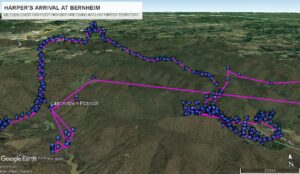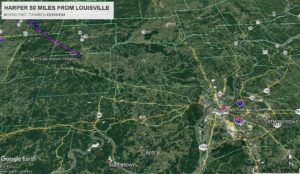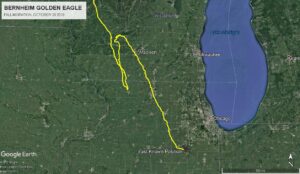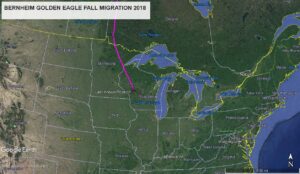By Andrew Berry

December 14, 2018
Forests are a big part of Bernheim’s identity. The large forest blocks that comprise Bernheim and exist throughout the knobs form a ring around the Bluegrass. The reason these forests still exist is mainly due to the steep terrain and topography found in the knobs, as anything with agricultural value has long ago been converted to pasture, crops, or developed for human habitats. It is these large forested blocks that are necessary for many species survival and are the reason for our rich biodiversity here at Bernheim.
The tracking of Harper, the golden eagle, has shed light on the importance of large forest blocks as critical winter habitat for golden eagles, leading to three main factors that seem to be required for establishing a territory. Researchers throughout the eastern United States have shown that golden eagles in the Appalachians and Mississippi Valley utilize large forest blocks as the main habitat. Steep and rugged terrain is another important factor in attracting golden eagles. Humans and their developed landscapes are avoided by golden eagles during winter range. To better understand the availability of habitat for golden eagles in Kentucky during the winter we have created a golden eagle model using GIS (geographic information system) to find which areas within Kentucky are suitable for these apex predators. The results are eye opening and demonstrate just how little habitat for golden eagles is found throughout central and western Kentucky.
The models (see images above; click on individual images to enlarge) show that winter habitat for golden eagles is largely concentrated on rugged terrain away from developed areas. A few things that stand out to me:
- Central Kentucky has very little habitat, especially in the Bluegrass region. The best remaining habitat in central Kentucky is in the knobs that form a chain from Louisville to the Daniel Boone National Forest and the Appalachian Plateau.
- Key areas in the knobs region exist in and around Bernheim Forest and Fort Knox. Other good areas are found in Casey and Marion County. This corridor of rugged and forested terrain is also used by black bear and other migratory species to move between Appalachia and the Midwest.
- Mammoth Cave, the Ohio River around Yellowbank Wildlife Management Area, and the area around the Cumberland River below the lake all have has considerable habitat remaining.
- Western Kentucky is largely poorer quality habitat, but areas do exist around Land Between the Lakes, Tradewater River, and the Green River.
- Eastern Kentucky still has a good amount of golden eagle habitat. Large areas exist throughout the Daniel Boone National Forest. Pine Mountain and Cumberland Mountains are all good habitats and have regular sightings of golden eagles migrating through the Appalachian corridor.
This model matches nicely to sightings of golden eagles throughout Kentucky. It also matches up well with the GPS tracks from Harper and the habitats he utilizes during the winter months. The results found here are useful for highlighting the importance of protecting large forest blocks if we want to keep this unique apex predator around central Kentucky. The midwestern golden eagle population and Harper are in danger from the continued loss of large forest blocks and fragmentation of their winter ranges. This golden eagle research project is one of many now demonstrating why we need to act to protect large forest blocks before they are gone.
It is a lot like humpty dumpty. Once he fell off the wall and was broken into pieces, no matter how much they tried it was not possible to put him back together again. I see the same situation with large forest blocks. Once fragmented by roads and development, no matter how hard we try there is no way to ever put these large forested blocks back together again. Let’s act while we can.
Stay tuned for our next installment highlighting at least 150,000 years of history between humans and golden eagles!
November 26, 2018
Golden eagles are present throughout central Kentucky during winter months, but seldom seen by people. Data on the winter range of Harper, the golden eagle tracked by Bernheim, show a strong aversion to people and the places they live. A nice example of that was seen on November 24, with an area used encompassing 2,500 acres. Several houses were avoided, and flight direction was rerouted when he became within half a mile of the residential area.
This pattern has been seen throughout our tracking of Harper. While at Bernheim he does not visit public areas such as the Arboretum or Forest Hill where we have hiking trails and picnic areas. He also does not fly over the Crooked Creek Boy Scout Camp and prefers to stay on the backside of their large lake. It has been shown over the past few years that with the exception of migration he almost never flies over residential areas while on his winter range. During summer in northern Manitoba he resides in an inaccessible area probably as remote as it gets in North America. This tracking project has shown that our golden eagle is not willing to share his territory with humans.
The fact he does not wish to reside near humans brought about two larger questions:
- Large interior forest blocks seem to be critical winter habitat for eastern golden eagles. What is the status of large forest blocks of several thousand acres in central Kentucky?
- What is more important, large forests or the lack of people, or a bit of both? How have interactions between humans and golden eagles led to the current habitat partitioning we see with Harper?
The next three pieces will focus on these questions, specifically:
- Large forest habitats for golden eagles in Central Kentucky
- Natural history of golden eagles in Kentucky
- Golden eagles and the history of interactions with humans

November 20, 2018
Harper, the golden eagle, has maintained a low profile since arriving at Bernheim on November 3rd. His movements have spanned an area of 5,000 acres, or nearly 8 square miles. His core range within that area has been less, with him using 2,000 acres of interior forest that include rugged knobs and mature forest. Several preferred roost locations have been identified on ridges with expansive views across the landscape.
During the ice storm on November 14-15th, Bernheim Forest took significant ice and lost many limbs throughout the forest including the high knobs. We can see from the GPS location data that Harper found refuge in a stand of Virginia pine on the mid-slope of a rugged section in Hart’s Run watershed. Conifers such as pine and cedar are critically important for birds and other wildlife as cover during ice and snow. Cedar thickets around my house were bustling with songbirds during the recent ice storm, where needles covered with an icy shell protect from wind and precipitation.
While the conditions during the ice storm were less than favorable to humans, the golden eagles that reside in Bernheim during winter come from subarctic Canada. They thrive in cold temperatures throughout their range with adaptations such as feathered legs and thick down feathers. Golden eagles are part of the booted eagle group, with feathers that cover their legs down to the feet. They experience conditions much more severe on the Hudson Bay lowlands, especially during the spring when Harper arrives on his breeding grounds in early April. We will continue to update in Harper’s activities during the fall, stay tuned for the latest developments.

November 4, 2018
Harper successfully completed his 1500 mile migration on Saturday, November 3, 2018. With spectacular accuracy he navigated across Fort Knox and flew directly to his preferred range in the Wilson Valley of Bernheim. It was amazing to watch his tracks move directly to his favorite locations from last winter in Bernheim.
As he flew towards Bernheim he made a final ascent reaching heights over 1000 feet, then descended at speeds up to 35 miles per hour directly into the Wilson Valley. He then flew back and forth over Harts Run and the Wilson Valley, at times as low as 20 feet above the ground surface. His movements back and forth across his winter range seemed to suggest that he was surveying the old favorite locations, much as we saw him do when he arrived on his summer range. Last spring he arrived near Churchill and immediately began visiting his preferred spots, including his nest site and favorite hunting locations.
The complete fall migration took just 19 days, beginning on October 16 and ending on November 3, 2018. We saw him use a similar route to his previous migrations, traveling an average of nearly 80 miles per day. Bernheim is elated to finally have the complete spring and fall migrations mapped, and begin to understand the complexities of a golden eagles flight patterns and stopovers.
It really says something that Harper would travel 1500 miles to the wilderness of northern Manitoba, spend the summer nesting, and then fly back to Kentucky in the fall and land directly in Bernheim Forest. This project has highlighted the importance of large protected areas of habitat for this apex predator, both on his summer and winter range. This is just one example of animals that migrate between Bernheim and far off locations, with others including monarchs, bats, raptors, and migratory songbirds. Stay tuned as we continue to interpret and decipher the life of a golden eagle on his winter range in Bernheim.

November 3, 2018
Harper continues to move south towards Louisville and Bernheim Forest. He has rapidly moved over Illinois and Indiana, crossing the Hoosier National Forest without stopping except for night roosting. On November 1, he roosted near Bloomfield, Indiana on a forested hillside. The next day he stayed in that location until past noon, then began traveling southeast and headed directly over Crane Naval Base, a location he used for spring migration in 2015. His last location on November 2 was 7 miles north of Paoli, Indiana.
He is moving quickly at this point, and with favorable weather on Saturday will likely make steady progress towards Louisville. He was just 50 miles from the Ohio River and Louisville. It is likely that by afternoon on November 3 he will be able to see the Bernheim knobs on the horizon. This is the first year we have been able to track his fall migration and many questions remain to his final approach. We will have updates as he gets closer, and then a detailed analysis of his final fall migration route and flight patterns next week. Thanks for your interest in Harper and hope you are as excited as we are at Bernheim to have him back for the winter.

October 31, 2018
Harper the golden eagle continues to head south towards his winter range at Bernheim. His travels have taken him to the southwest of Chicago on a route very similar to his previous migrations. We continue to see spectacular flight patterns with speed topping out at 62 miles per hour and height above the earth at over 3000 foot. This is migration route is very familiar to Harper, and for the remainder of his journey he should be within cellular transmission range allowing for daily updates. Questions still remain such as whether he travels alone, with a mate, or even possibly with mate and their offspring from this past summer’s breeding season in Canada. We are also interested in whether he will come directly to Bernheim when he finally enters Kentucky. Stay tuned as we continue to monitor his migration.

October 26, 2018
After 184 days in the wilderness of the Hudson Bay lowlands in Canada, the golden eagle known as Harper has begun his journey back to Bernheim Forest. The fall migration started on October 16th, traveling south across Manitoba and crossing into the United States on October 23 headed directly for the western tip of Lake Superior at Duluth, MN. This route has been followed for each spring and fall migration tracked so far.
During his summer months in northern Manitoba, we saw Harper use a small cluster of lakes totaling about 60 square miles of home range. The data shows that he is using the same cluster of lakes as in 2015. This is an example of the strong site fidelity for nesting, meaning Harper and his golden eagle mate likely use this site yearly because of an abundance of food and the existence of a favorable nesting location.
We expect Harper will continue his travels south towards Bernheim and arrive sometime in early November. Stay tuned as we continue updates on his movements and activities while on the winter range in Bernheim.
To learn more about Harper click here.

